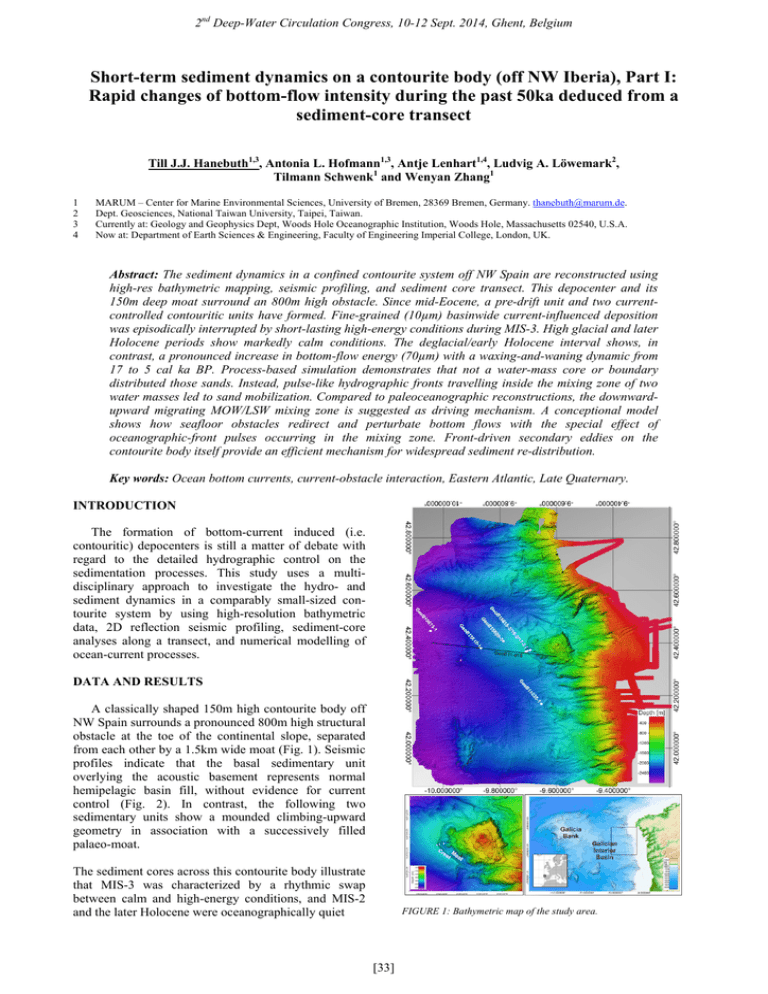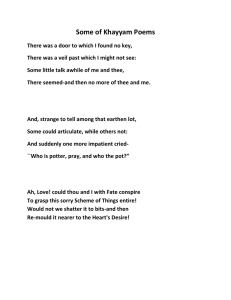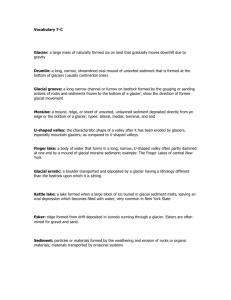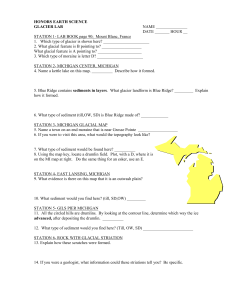Short-term sediment dynamics on a contourite body (off NW Iberia),... Rapid changes of bottom-flow intensity during the past 50ka deduced...
advertisement

2nd Deep-Water Circulation Congress, 10-12 Sept. 2014, Ghent, Belgium Short-term sediment dynamics on a contourite body (off NW Iberia), Part I: Rapid changes of bottom-flow intensity during the past 50ka deduced from a sediment-core transect Till J.J. Hanebuth1,3, Antonia L. Hofmann1,3, Antje Lenhart1,4, Ludvig A. Löwemark2, Tilmann Schwenk1 and Wenyan Zhang1 1 2 3 4 MARUM – Center for Marine Environmental Sciences, University of Bremen, 28369 Bremen, Germany. thanebuth@marum.de. Dept. Geosciences, National Taiwan University, Taipei, Taiwan. Currently at: Geology and Geophysics Dept, Woods Hole Oceanographic Institution, Woods Hole, Massachusetts 02540, U.S.A. Now at: Department of Earth Sciences & Engineering, Faculty of Engineering Imperial College, London, UK. Abstract: The sediment dynamics in a confined contourite system off NW Spain are reconstructed using high-res bathymetric mapping, seismic profiling, and sediment core transect. This depocenter and its 150m deep moat surround an 800m high obstacle. Since mid-Eocene, a pre-drift unit and two currentcontrolled contouritic units have formed. Fine-grained (10µm) basinwide current-influenced deposition was episodically interrupted by short-lasting high-energy conditions during MIS-3. High glacial and later Holocene periods show markedly calm conditions. The deglacial/early Holocene interval shows, in contrast, a pronounced increase in bottom-flow energy (70µm) with a waxing-and-waning dynamic from 17 to 5 cal ka BP. Process-based simulation demonstrates that not a water-mass core or boundary distributed those sands. Instead, pulse-like hydrographic fronts travelling inside the mixing zone of two water masses led to sand mobilization. Compared to paleoceanographic reconstructions, the downwardupward migrating MOW/LSW mixing zone is suggested as driving mechanism. A conceptional model shows how seafloor obstacles redirect and perturbate bottom flows with the special effect of oceanographic-front pulses occurring in the mixing zone. Front-driven secondary eddies on the contourite body itself provide an efficient mechanism for widespread sediment re-distribution. Key words: Ocean bottom currents, current-obstacle interaction, Eastern Atlantic, Late Quaternary. INTRODUCTION The formation of bottom-current induced (i.e. contouritic) depocenters is still a matter of debate with regard to the detailed hydrographic control on the sedimentation processes. This study uses a multidisciplinary approach to investigate the hydro- and sediment dynamics in a comparably small-sized contourite system by using high-resolution bathymetric data, 2D reflection seismic profiling, sediment-core analyses along a transect, and numerical modelling of ocean-current processes. DATA AND RESULTS A classically shaped 150m high contourite body off NW Spain surrounds a pronounced 800m high structural obstacle at the toe of the continental slope, separated from each other by a 1.5km wide moat (Fig. 1). Seismic profiles indicate that the basal sedimentary unit overlying the acoustic basement represents normal hemipelagic basin fill, without evidence for current control (Fig. 2). In contrast, the following two sedimentary units show a mounded climbing-upward geometry in association with a successively filled palaeo-moat. The sediment cores across this contourite body illustrate that MIS-3 was characterized by a rhythmic swap between calm and high-energy conditions, and MIS-2 and the later Holocene were oceanographically quiet FIGURE 1: Bathymetric map of the study area. [33] 2ndd Deep-Water Circulation C Congress, 10-1 12 Sept. 2014,, Ghent, Belgiium intervals. M Most notably is the deg glacial to eaarly Holocene tim me interval, neevertheless; with w an episodee of remarkable bottom-currrent intensiffication rapiidly waxing-and-w waning dynam mics were sen nsitively recorrded across the coore transect (Fig. 3). lasst deglacial to early Holocenne times. Witth the general,, clim mate-driven decrease inn salinity leeading to a weeakening of th he lower Medditerranean Outflow O Waterr (M MOW) core in the outflow rregion (the Gulf of Cadiz),, thee upper MOW W core has preesumably streengthened andd duee to an increaase in its saliinity, temporaarily (17-5ka)) deeepened by th he identified 300m in th he study areaa (Scchönfeld and Zahn, Z 2000). CO ONCLUSION NS This study refines r the cooncept how medium-sized m d seaafloor obstaccles redirect and perturrbate bottom m currrents on loccal scale. Shharply defined d water-masss bou undaries aree not necesssarily the hydrographicc eleements to prov vide high-enerrgy conditions but, instead,, a rather r transitiional zone beetween two water w massess might provide a powerful bottom-flow w and, thus,, sed diment transport regime. T The well-sorted sands seem m to originate fro om the moatt itself, insteead of beingg dellivered from a remote souurce and tran nsported overr lon ng distances. The migratiting eddy sy ystem on thee con ntourite body itself providdes an efficien nt mechanism m to distribute these sediments in suspension n equally overr thee area. FIGURE 2: Seissmic profile acrosss the contourite body. A 3-D pprocess-based sediment-traansport modell is applied baseed on differennt scenarios in n which the ttwo major waterr masses (M MOW and LSW) potentiaally responsible for sediment dynamics on n the contouurite body are reggulated, mimiicking the mo odern and palleooceanographhic conditions.. Simulation results r excludde a water-mass ccore as forcee driving an evolution of the system. It cclearly indicaates, instead,, that pulse-llike appearing froonts within thhe approximaately 300m thhick water-mass mixing zonne have th he potential to remobilize annd distribute fine sands. Th hese fronts caause local bottom m currents insside the moatt as well as kkmscaled eddiess on the gentlle seaward-directed contouurite flank. Such m migrating fronnts are well kn nown as comm mon elements in tthe modern hyydrographic sy ystem, but apppear on the steepp and bare-off-sediments middle m slope off Galicia at present (Fig. 4). 4 Thus, thee resulting sanndy contouritic sediment recorrd is not main nly controlledd by a net increasse in front ennergy within this t mixing zzone but by the teemporary clim mate-related deepening d of this zone of abouut 300m. FIG GURE 4: Conceptional scheme coomparing the mod dern (yellow) andd deg glacial/early Holo ocene (orange) LLSW/MOW mixin ng zones. Whilstt the modern mixing zone z interacts witth the middle slop pe and the top off the obstacle (possib bly producing m morphological/ero osional terraces),, the 300m lower palaeo-mixing zone with its hydrogrraphic fronts andd ociated eddies had strong imppact on the co ontouritic system m asso sed dimentation. RE EFERENCES S Haanebuth, T.J.J., A.L. Hofmaann, A.L., Löw wemark, L.A.,, Schwenk, T., Zhang, W., subm. Hydrog graphic frontss controlling bottom-curreent sedimen nt dynamicss deduced from m a 2D contoourite sedimen nt record andd 3D process-b based numericcal simulation n. Sch hönfeld, J., Zahn, R., 20000. Late Glacial to Holocenee history of thee Mediterraneean outflow. Evidence E from m benthic forraminiferal aassemblages and stablee isotopes at th he Portuguesee margin. Palaaeogeography,, Palaeoclimattology, Palaeooecology 159, 85-111. Vö ölker, A.H.L., Lebreiro, S.M M., Schönfeld,, J., Cacho, I.,, Erlenkeuser, H., Abrantess, F., 2006. Mediterranean M n outflow strengthening duuring northern n hemispheree coolings: a salt source forr the glacial Atlantic? A Earthh Planetary Science Letters 2245, 39-55. FIGURE 3: Graain-size distributtion during the peeriod 20-0 cal kaa BP illustrating thee offshore graddients as well as duration off the coarsening duriing the deglacial//early Holocene in nterval. The com mparison withh existing pallaeoceanograpphic data suggessts that finee-grained dep position on the contourite boody was driveen by the Lab brador Sea Waater (LSW) over m major parts off the past 50kaa. A short-lastting increase in bbottom velociity during Daansgard-Oeschhger intervals (V Völker et all., 2006) caan be obserrved throughout thhe basin. Thee most remark kable intervall of sediment traansport intenssification occu urred during the [34]




